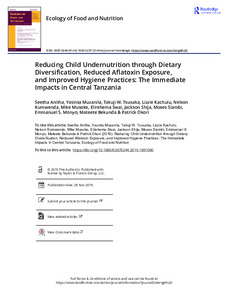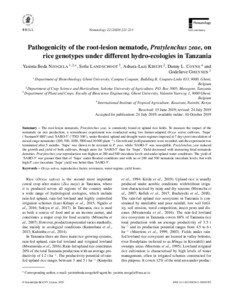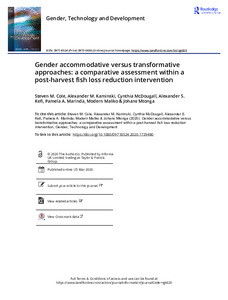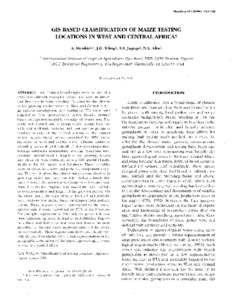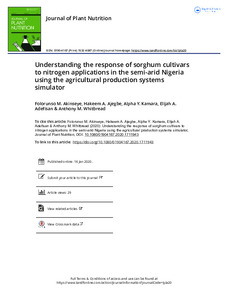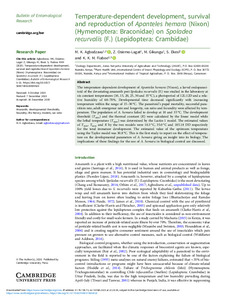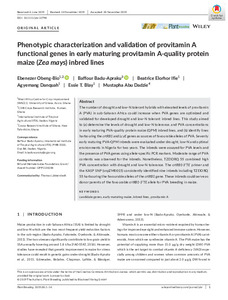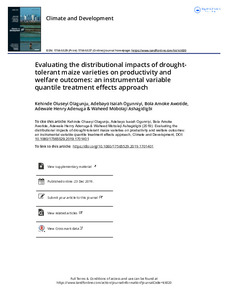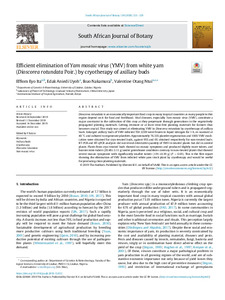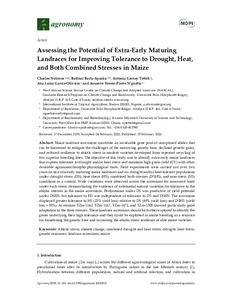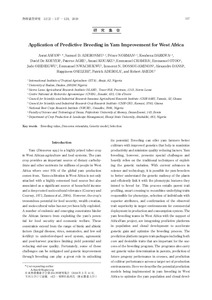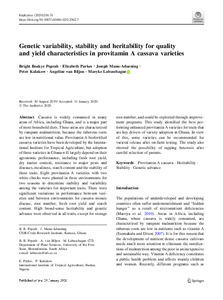Welcome to the International Institute of Tropical Agriculture Research Repository
Journal and Journal Articles: Recent submissions
Now showing items 721-740 of 5266
-
Reducing child undernutrition through dietary diversification, reduced aflatoxin exposure, and improved hygiene practices: the immediate impacts in central Tanzania
(2019-11-28)The study aimed to quantify the immediate effects of dietary diversification, food safety, and hygiene interventions on child undernutrition in four rural villages in Kongwa district of central Tanzania. One hundred mothers with their children of less than 24 months old were recruited for this study. The difference-in-difference (DID) method was used to assess the effects of intensive intervention through a learning-by-doing process on the topic of aflatoxin free diversified food utilization and ... -
Seed dressing maize with imazapyr to control Striga hermonthica in farmers’ fields in the
(2020-03-17)Use of small doses of imazapyr and pyrithiobac for seed coatings of imazapyr-resistant maize hybrids (IR-Maize) offers an effective means to control Striga hermonthica. Field trials were conducted in Bauchi and Kano States of Nigeria in 2014 and 2015 under heavy Striga infestation to evaluate the potential effectiveness of herbicide coated hybrids maize on Striga control in farmers’ field. Results showed that herbicide coated seeds reduced number of emerged Striga per m2 and Striga damage symptoms ... -
Production of banana bunchy top virus (BBTV)-free plantain plants by in vitro culture
(2020-03)Banana Bunchy Top Disease (BBTD) caused by the Banana Bunchy Top Virus (BBTV) is one of the most important banana diseases in the Democratic Republic of Congo. This study focused on the production of BBTV-free plantain seedlings from infected banana plants. A total of 10 suckers from the French plantain Litete (Musa AAB) and the False Horn plantain Libanga Likale (Musa AAB) with advanced BBTD symptoms were collected. Meristematic apices excised from those suckers were cultured in vitro and subcultured ... -
Pathogenicity of the root-lesion nematode, pratylenchus zeae, on rice genotypes under different hydro-ecologies in Tanzania
(2020)The root-lesion nematode, Pratylenchus zeae, is commonly found in upland rice fields. To measure the impact of the nematode on rice production, a screenhouse experiment was conducted using two farmer-adapted Oryza sativa cultivars, ‘Supa’ (‘SurinamV-880’) and ‘SARO-5’ (‘TXD 306’), under flooded, upland and drought water regimes imposed at 7 days post-inoculation of mixed-stage nematodes (200, 500, 1000, 3000 and 10 000 plant−1). Growth and yield parameters were recorded, and the experiment was ... -
Gender accommodative versus transformative approaches: a comparative assessment within a post-harvest fish loss reduction intervention
(2020-03-25)Technical and social constraints limit value chain actors from equitably engaging in and benefiting from capture fisheries in low-income settings. Extension and development programs often focus on the former, which reflects a technocratic orientation of the fisheries sector and uncertainty about effective ways for development programs to engage with gender and other social constraints. This study presents empirical insights that address these challenges to fisheries development. The study took ... -
Free-living nematode assemblages in the rhizosphere of watermelon plants in Nigeria: a baseline study
(2020)Watermelon is increasingly produced and consumed in Nigeria and sub-Saharan Africa. However, limited information exists regarding nematode pests and beneficial/free-living nematodes associated with the crop. The present study recorded the abundance and diversity of free-living nematodes from 50 watermelon fields across south-west Nigeria during 2016/2017. Of the 30 genera identified from soil samples, Cephalobus, followed by Rhabditis, Aphelenchus and Aporcelaimus, were predominant. Variation in ... -
Extruded flakes from pearl millet (Pennisetum glaucum)-carrot (Daucus carota) blended flours-production, nutritional and sensory attributes
(2020)Millet flour (M) and carrot flour(C) were produced and blended in the ratios 100M:0C, 95M:5C, 90M:10C, 85M:15C and 80M:20C respectively to produce extruded flakes. The composite flours were subjected to analysis of the proximate and mineral composition, as well as functional and pasting properties. Extruded flakes were analyzed for proximate composition, total carotenoids, colour and sensory evaluation. There was no significant difference (p > 0.05) in the proximate, functional and pasting properties ... -
GIS based classification of maize testing locations in West and Central Africa
(2000)Stratifying a broad target growing area of a crop into different ecological zones has been an important first step in plant breeding. To cater for the diverse maize growing environments in West and Central Africa, germplasm development and testing at IITA have been targeted to four agroecological zones broadly defined based on experiences and knowledge of researchers. This study was carried out to group maize testing locations with similar climatic features, and then use the groups to produce a ... -
Understanding the response of sorghum cultivars to nitrogen applications in the semi-arid Nigeria using the agricultural production systems simulator
(2020-01-16)The Agricultural Production Systems simulator (APSIM) model was calibrated and evaluated using two improved sorghum varieties conducted in an experiment designed in a randomized complete block, 2014–2016 at two research stations in Nigeria. The results show that the model replicated the observed yield accounting for yield differences and variations in phenological development between the two sorghum cultivars. For early-maturing cultivar (ICSV-400), the model indicated by low accuracy with root ... -
Temperature-dependent development, survival and reproduction of Apanteles hemara (Nixon) (Hymenoptera: Braconidae) on Spoladea recurvalis (F.) (Lepidoptera: Crambidae)
(2020-02-18)The temperature-dependent development of Apanteles hemara (Nixon), a larval endoparasitoid of the devastating amaranth pest Spoladea recurvalis (F.) was studied in the laboratory at six constant temperatures (10, 15, 20, 25, 30 and 35 °C), a photoperiod of 12L:12D and a relative humidity of 60–70%. Developmental time decreased significantly with increasing temperature within the range of 15–30 °C. The parasitoid's pupal mortality, successful parasitism rate, adult emergence rate and longevity, sex ... -
Plant tissue analysis as a tool for predicting fertiliser needs for low cyanogenic glucoside levels in cassava roots: an assessment of its possible use
(2020-02-13)The use of plant tissue analysis as a tool for attaining low cyanogenic glucoside levels in cassava roots, has hardly been investigated. Just as the quality of crops is improved through the use of plant tissue analysis, the same can probably be done to consistently attain the lowest possible cyanogenic glucoside levels in cassava roots. High levels of cyanogenic glucosides in consumed fresh cassava roots or in their products have the potential of causing cyanide intoxication, hence the need to ... -
Phenotypic characterization and validation of provitamin A functional genes in early maturing provitamin A-quality protein maize (Zea mays) inbred lines
(2019)The number of drought and low‐N tolerant hybrids with elevated levels of provitamin A (PVA) in sub‐Saharan Africa could increase when PVA genes are optimized and validated for developed drought and low‐N tolerant inbred lines. This study aimed to (a) determine the levels of drought and low‐N tolerance, and PVA concentrations in early maturing PVA‐quality protein maize (QPM) inbred lines, and (b) identify lines harbouring the crtRB1 and LcyE genes as sources of favourable alleles of PVA. Seventy ... -
Improving the efficiency of Beauveria bassiana applications for sustainable management of Plutella xylostella (Lepidoptera: Plutellidae) in West Africa
(2020-05)The effectiveness of the entomopathogenic fungus Beauveria bassiana (Balsamo) Vuillemin isolates Bb11, Bb115, Bb116 and Bb362 against the diamondback moth (DBM), Plutella xylostella (L.) population from Cotonou, Benin, was investigated in the laboratory and on station. In the laboratory, six concentrations, 104, 105, 106, 107, 108 and 109 conidia/ml of each isolate were used to assess B. bassiana virulence. Third instar DBM larvae were inoculated with 2 µl of each isolate’s concentrations by topical ... -
Farm production diversity: is it important for dietary diversity? Panel data evidence from Uganda
(2020-01-31)The substantial existence of malnutrition globally, especially in developing countries, has usually driven policy initiatives to focus on improving household food security and nutrition primarily through prioritizing farm production diversity. Although indeed some empirical evidence has pointed to farm production diversity remedying malnutrition, other evidence has pointed to markets. Therefore, evidence is mixed and may be country or region variant. To contribute to closing such a gap in the ... -
Evaluating the distributional impacts of drought tolerant maize varieties on productivity and welfare outcomes: an instrumental variable quantile treatment effects approach
(2019-12-23)In an attempt to go beyond the conventional mean impact assessment of agricultural interventions, this paper examines the distributional impacts of adoption of drought-tolerant maize varieties (DTMVs) on the productivity and welfare outcomes of rural farming households in Nigeria. The study employed a conditional instrumental variable quantile treatment effects approach to control for selection bias that may arise from both observed and unobserved factors. The empirical findings revealed that ... -
Efficient elimination of Yam mosaic virus (YMV) from white yam (Dioscorea rotundata Poir.) by cryotherapy of axillary buds
(2020-05)Dioscorea rotundata is an economically important food crop in many tropical countries as many people in this region depend on it for food and livelihood. Viral diseases, especially Yam mosaic virus (YMV), constitute a major constraint in the cultivation of this crop as they perpetuate through generations in the vegetatively propagated planting materials. Getting resistant or at least virus-free planting materials for farmers thus becomes crucial. This study was aimed at eliminating YMV in Dioscorea ... -
Assessing the potential of extra-early maturing landraces for improving tolerance to drought, heat, and both combined stresses in maize
(2020-02-25)Maize landrace accessions constitute an invaluable gene pool of unexplored alleles that can be harnessed to mitigate the challenges of the narrowing genetic base, declined genetic gains, and reduced resilience to abiotic stress in modern varieties developed from repeated recycling of few superior breeding lines. The objective of this study was to identify extra-early maize landraces that express tolerance to drought and/or heat stress and maintain high grain yield (GY) with other desirable ... -
A review of inclusive business models and their application in aquaculture development
(2020)For aquaculture to continue along its current growth trajectory and contribute towards achieving the Sustainable Development Goals, value chains must become more inclusive. Smallholders and other local value chain actors are often constrained by circumstances and market failures in the global aquaculture industry. Integrating these actors into aquaculture value chains through inclusive business models (IBMs) is often touted as a solution to sustainable and ethical trade and business that can ... -
Genetic variability, stability and heritability for quality and yield characteristics in provitamin A cassava varieties
(2020)Cassava is widely consumed in many areas of Africa, including Ghana, and is a major part of most household diets. These areas are characterized by rampant malnutrition, because the tuberous roots are low in nutritional value. Provitamin A biofortified cassava varieties have been developed by the International Institute for Tropical Agriculture, but adoption of these varieties in Ghana will largely depend on their agronomic performance, including fresh root yield, dry matter content, resistance to ...

